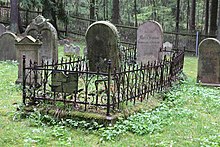Moses Simson

Moses Simson (born January 2, 1808 in Schwarza , † December 11, 1868 in Suhl ) was a German entrepreneur and co-founder of the Simson works in Suhl.
Life
Moses Simson came from a Jewish family from Heinrichs . His grandfather Liebmann Simson, son of Simson Liebmann from Mühlfeld , had worked as a farmhand for the cattle dealer Moses Meyer in Heinrichs from 1765 . After receiving a letter of protection from Count Heinrich Ernst zu Stolberg-Wernigerode in 1773 , the family moved to nearby Schwarza . His first-born son Simson Liebmann (1785–1812), the father of Moses, traded in fabrics, towels, beds and clothes and lent money. As a result, he made a small fortune and left his sons Löb Simson (1806–1862) and Moses Simson 11,939 Reichstaler at his early death.
The brothers worked as dealers from the 1840s. Since in the course of the Jewish emancipation the Jews were able to purchase land, they bought real estate at auction and bought shares in insolvent companies. Löb and Moses bought house no.116 on the market in Suhl in 1848 for 812 Reichstaler. Moses lived there with his family and, with Löb, opened a fabric and clothing store in 1850, which was operated as a trading company under the name “Gebr. Simson ”was active.
In 1854, the Simson brothers acquired a third of the "old steel hammer " in Heinrichs, which was founded in 1741 by Andreas Bauer and in which ore was melted and forged into steel blocks and bars. Among other things, axes , chisels , halberds and pipes for the gunsmithing trade in Suhl were produced from this.
In 1856 Löb and Moses already owned 7/12 shares in the company, which in 1866 was wholly owned by the Simson family. They called it "Simson & Co". Initially only charcoal steel was produced, some of which was further processed into black plate. Production was discontinued a short time later due to poor quality. In the years that followed, the product was used for the manufacture of stabbing and firearms , which were produced by around 20 employees. In 1862 the company “Gebr. Simson ”entered the Suhl commercial register as a bayonet and ramrod factory . The owners were Löb and Moses Simson.
In the course of a business expansion, Moses Simson took the local gunsmith Karl Luck as a partner in the company, which was registered in 1865 as a general partnership "Simson & Luck / Suhl". Luck was involved in the business proceeds, but had no rights of disposal over the company.
family

Moses Simson and his wife Louise had seven sons, Simson (1838–1907), Gerson (1845–1904), Leopold (1847–1870), Hugo (1852–1926), Luis (1854–1948), Daniel (1858–1892 ) and Julius (1860–1938) and their daughter Emilie (1841–1901). After the death of Moses in 1868, Louise ran the company with Karl Luck for six years until her son Gerson joined the company. The son Hugo took over the Suhler trading business and Julius became managing director of the porcelain factory “Gebr. Simson ” in Gotha , which became family property in 1883. The sons Louis and Daniel emigrated to the USA and Leopold was killed in the Franco-Prussian War .
In 1884 Karl Luck left the company and from 1887 the company name was "Simson and Co., formerly Simson & Luck". From July 3, 1899, the company was only called "Simson and Co." and a branch was founded in Mohrenstrasse in Berlin. It was a trade office that maintained contacts with army services at home and abroad.
When Gerson Simson died in 1904, Simson had 1200 employees, making the company the largest employer in the area. Gerson Simson was buried in the Jewish cemetery in Suhl . His widow Jeanette Simson (1847–1926), with whom he had seven children, gave four sons the management of the Simson works. Max Simson (1871–1924) took over the management of the Berlin branch and Leonhard (1878–1929) became the company's authorized signatory and commercial director. The younger brothers Arthur Simson (1882–1969) and Julius Simson (1884–1953) attended university first. You joined the management in 1921 as technical director in Suhl and in 1924 as successor to Max Simson as lawyer and managing director. The fifth son Ernst Simson (1874–1953), a lawyer, and the daughters Rosalie (1876–1962) and Minna (1879–1975) were not involved in the management of the company.
Jeanette Simson headed the Simson Foundation, which her husband had founded to support the Suhl poor relief and gifted secondary school students. In 1911, the well-known Berlin architect Hermann Muthesius built a new, representative villa on Suhl Domberg. In 1936 the siblings Arthur, Julius, Rosalie and Minna fled to the USA with their families due to the National Socialist dictatorship .
literature
- Thomas Müller: Simson. In: New German Biography (NDB). Volume 24, Duncker & Humblot, Berlin 2010, ISBN 978-3-428-11205-0 , pp. 449-451 ( digitized version ).
- Ulrike Schulz: Simson About the improbable survival of a company 1856-1993 . Wallstein Verlag, Göttingen 2013, ISBN 978-3-8353-1256-2
Web links
Individual evidence
- ↑ a b c d Ulrike Schulz: Simson From the improbable survival of a company 1856-1993 . Wallstein Verlag, Göttingen 2013, ISBN 978-3-8353-1256-2
| personal data | |
|---|---|
| SURNAME | Samson, Moses |
| BRIEF DESCRIPTION | German entrepreneur |
| DATE OF BIRTH | January 2, 1808 |
| PLACE OF BIRTH | Schwarza (Thuringian Forest) |
| DATE OF DEATH | December 11, 1868 |
| Place of death | Suhl |